
Deutsch-Chinesische Enzyklopädie, 德汉百科
 History of Ancient Greece
History of Ancient Greece
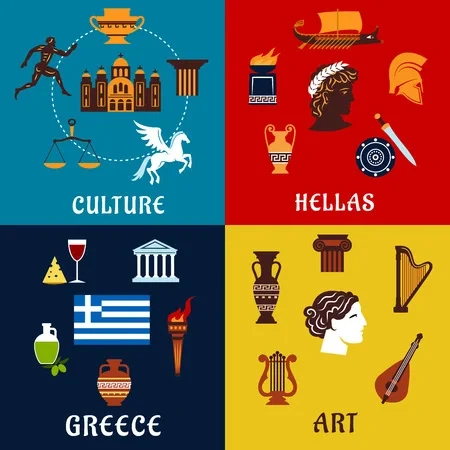

Als Dunkles Zeitalter Griechenlands wird traditionell die Zeit ab ca. 1200 v. Chr., dem Ende der sogenannten Mykenischen Palastzeit, bis zum Aufschwung in der orientalisierenden Zeit um 750 v. Chr. bezeichnet. Weil man aus diesem Zeitraum keine Schriftquellen und vergleichsweise wenig archäologische Funde kennt, gilt die Zeit als „Dunkles Zeitalter“. In den letzten Jahrzehnten wurde eine ganze Reihe archäologische Entdeckungen gemacht, die wesentlich mehr Licht in die „Dunklen Jahrhunderte“ brachten. Besonders das 12. Jahrhundert v. Chr. und das frühe 8. Jahrhundert v. Chr. sind nun besser erforscht, so dass mittlerweile oft nur noch für die Periode zwischen 1050 v. Chr. und 800 v. Chr. von einem „Dunklen Zeitalter“ gesprochen werden kann.
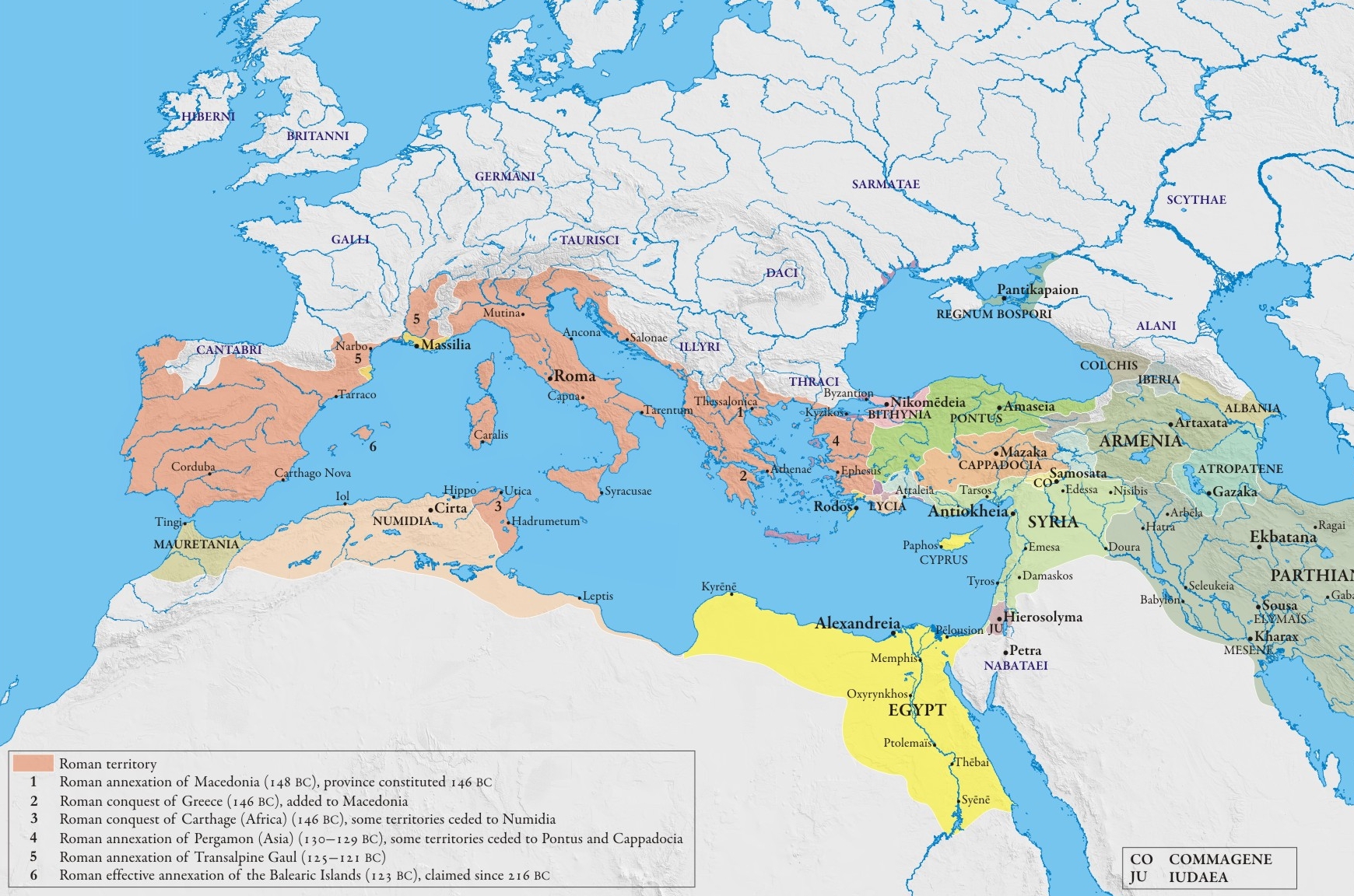
希腊的罗马时期是希腊历史中的一段期间,从西元前146年罗马人占领科林斯开始,直到君士坦丁一世于330年将罗马帝国的首都从罗马迁到拜占庭,并将该地改称新罗马为止。
在罗马统治时期,不少罗马皇帝为希腊城市增添了新建筑,特别是雅典的古雅典阿哥拉,风之塔遗址亦在其中。此时期希腊人的生活大概与希腊化时代一致。而古罗马文化亦在很大程度上受到希腊文化的影响。同样地,许多罗马皇帝亦有仰慕希腊文化,如尼禄就曾于66年出访希腊,并参与了古代奥林匹克运动会。另外,哈德良(117-138年在位)亦崇尚希腊文化,既在雅典卫城外建造了哈德良拱门,又在雅典城建了不少神庙。
同时期基督教开始向希腊和罗马帝国东部传播,如圣保罗就曾在第二、三次传教旅行到马其顿、帖撒罗尼迦、哥林多和雅典传教。希腊逐渐成为罗马帝国内基督教传播率最高的地区之一。
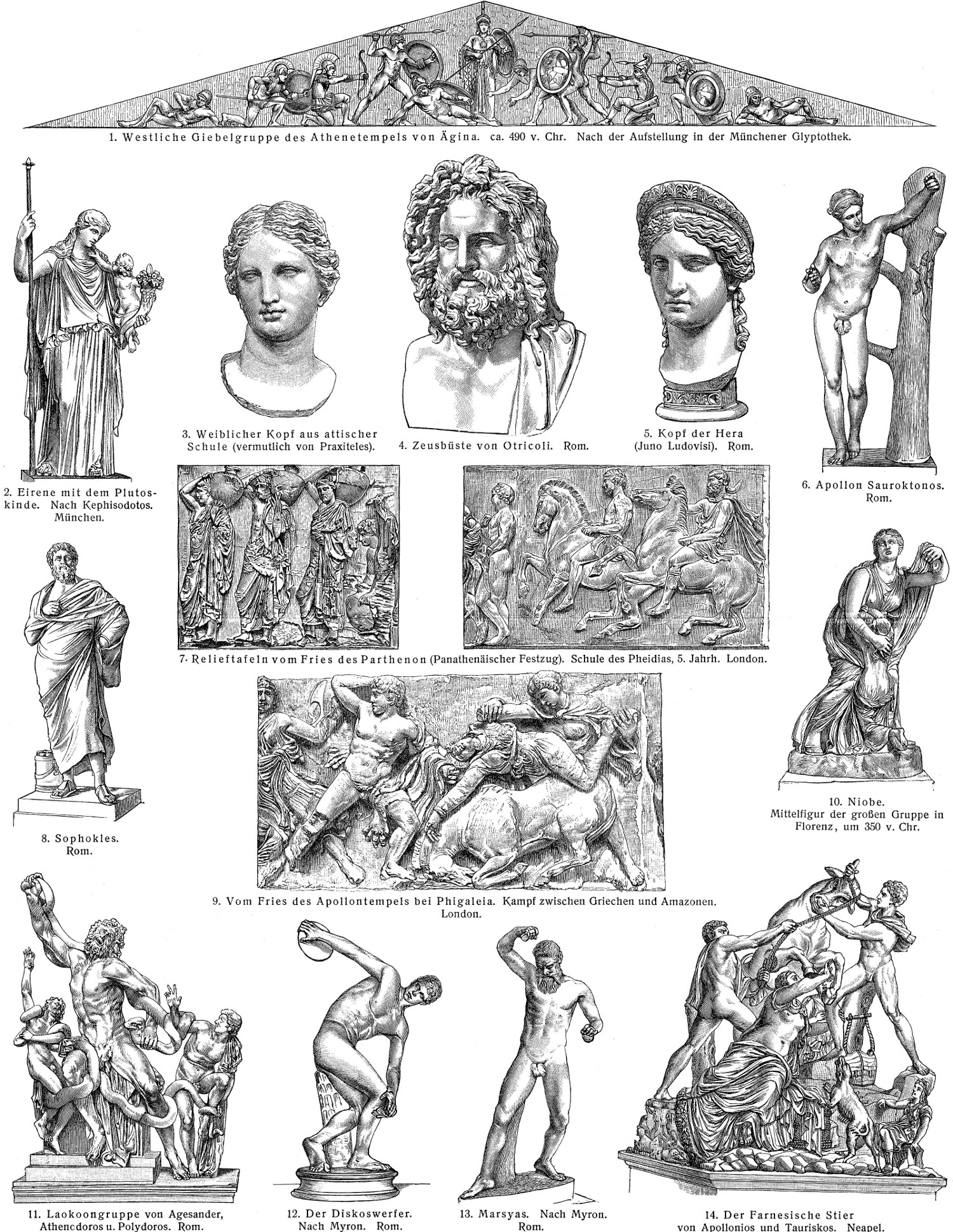
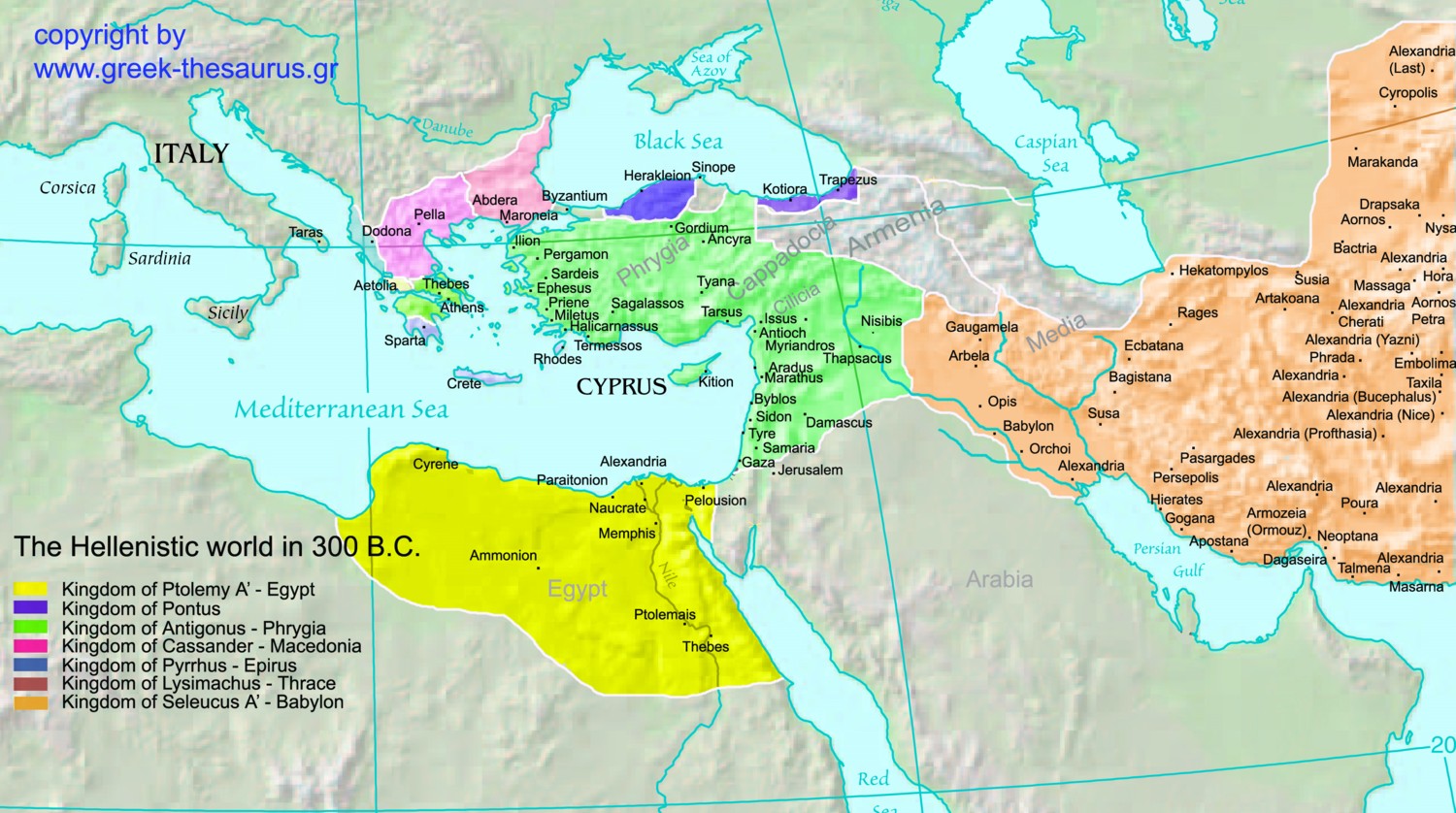
希腊化时代(英语:Hellenistic period)在亚历山大征服波斯帝国之后不久开始。通常起始点视为亚历山大大帝于公元前323年逝世开始,并结束于罗马共和国在前146年征服希腊本土,或前30年最后的继业者王国——托勒密王国灭亡为止[1]。这段时期,19世纪后西方史学界认为古希腊文明主宰整个地中海东部沿岸的文明,所以称此地这段时期为希腊化时代。希腊化时代被认为是希腊古典时代和罗马文化间的过渡时期,与希腊古典时代相比,被认为文化上呈现下降或衰退的趋势[1]。希腊化时期的特点是新的一波的希腊殖民活动,并主要以埃及和西亚的各希腊化王国内建立殖民城市为主[2]。
Als Hellenismus (von griechisch Ελληνισμός hellēnismós ‚Griechentum‘)[1] wird die Epoche der antiken griechischen Geschichte vom Regierungsantritt Alexanders des Großen von Makedonien 336 v. Chr. bis zur Einverleibung des ptolemäischen Ägyptens, des letzten hellenistischen Großreiches, in das Römische Reich im Jahr 30 v. Chr. bezeichnet.
Diese Epochengrenzen, die die Großreiche Alexanders und der Diadochen in den Mittelpunkt rücken, sind allerdings nur für die politische Geschichte sinnvoll. Kulturgeschichtlich hingegen knüpfte der Hellenismus nicht nur an ältere Entwicklungen an, sondern wirkte vor allem auch über die römische Kaiserzeit bis in die Spätantike hinein fort.
Als Epochenbezeichnung verwendete den Begriff „Hellenismus“ zuerst der deutsche Historiker Johann Gustav Droysen um die Mitte des 19. Jahrhunderts. Er verstand unter Hellenismus die Zeit vom Tod Alexanders des Großen (323 v. Chr.) bis zur Schlacht bei Actium (31 v. Chr.) und dem Ende des letzten griechischen Reiches in Indien. Im Sinne von „Nachahmung der griechischen Lebensweise“ wurden das Substantiv „hellenismós“ und das Verb „hellenizein“ jedoch bereits in der Antike gebraucht.[2] Es ist von Hellenen, der Eigenbezeichnung der Griechen, abgeleitet.
Als ein wichtiges Kennzeichen dieser Geschichtsepoche gilt eine verstärkte Hellenisierung, die Durchdringung vor allem des Orients durch die griechische Kultur, und im Gegenzug der wachsende Einfluss orientalischer Kultur auf die Griechen. Die hellenistische Welt umfasste einen gewaltigen Raum, der von Sizilien und Unteritalien (Magna Graecia) über Griechenland bis nach Indien und vom Schwarzen Meer bis nach Ägypten und bis ins heutige Afghanistan reichte. Die Hellenisierung der orientalischen Bevölkerung sorgte dafür, dass noch bis ins 7. Jahrhundert neben dem Aramäischen wenigstens von der städtischen Bevölkerung Syriens eine Form des Griechischen verwendet wurde, die Koine (von κοινός koinós „allgemein“), die sich in Kleinasien noch erheblich länger hielt. Die kulturellen Traditionen des Hellenismus überstanden den politischen Zusammenbruch der Monarchien und wirkten noch über Jahrhunderte in Rom und im Byzantinischen Reich fort.
ヘレニズム(Hellenism)とは、ギリシア人(ヘレネス)の祖、ヘレーンに由来する語。その用法は様々であり、アレクサンドロスの東方遠征によって生じた古代オリエントとギリシアの文化が融合した「ギリシア風」の文化を指すこともあれば、時代区分としてアレクサンドロス3世(大王)(在位前336年 - 前323年)の治世からプトレマイオス朝エジプトが滅亡するまでの約300年間を指すこともある。また、ヨーロッパ文明の源流となる2つの要素として、ヘブライズムと対置してヘレニズムが示される場合もある。この場合のヘレニズムは古典古代の文化(ギリシア・ローマの文化)におけるギリシア的要素を指す。
The Hellenistic period covers the period of Mediterranean history between the death of Alexander the Great in 323 BC and the emergence of the Roman Empire as signified by the Battle of Actium in 31 BC[1] and the subsequent conquest of Ptolemaic Egypt the following year.[2] The Ancient Greek word Hellas (Ἑλλάς, Ellás) is the original word for Greece, from which the word Hellenistic was derived.[3]
At this time, Greek cultural influence and power was at its peak in Europe, North Africa and Western Asia, experiencing prosperity and progress in the arts, exploration, literature, theatre, architecture, music, mathematics, philosophy, and science. It is often considered a period of transition, sometimes even of decadence or degeneration,[4] compared to the enlightenment of the Greek Classical era. The Hellenistic period saw the rise of New Comedy, Alexandrian poetry, the Septuagint and the philosophies of Stoicism and Epicureanism. Greek science was advanced by the works of the mathematician Euclid and the polymath Archimedes. The religious sphere expanded to include new gods such as the Greco-Egyptian Serapis, eastern deities such as Attis and Cybele and a syncretism between Hellenistic culture and Buddhism in Bactria and Northwest India.
After Alexander the Great's invasion of the Achaemenid Empire in 330 BC and its disintegration shortly after, the Hellenistic kingdoms were established throughout south-west Asia (Seleucid Empire, Kingdom of Pergamon), north-east Africa (Ptolemaic Kingdom) and South Asia (Greco-Bactrian Kingdom, Indo-Greek Kingdom). The Hellenistic period was characterized by a new wave of Greek colonization[5] which established Greek cities and kingdoms in Asia and Africa.[6] This resulted in the export of Greek culture and language to these new realms, spanning as far as modern-day India. Equally, however, these new kingdoms were influenced by the indigenous cultures, adopting local practices where beneficial, necessary, or convenient. Hellenistic culture thus represents a fusion of the Ancient Greek world with that of the Near East, Middle East, and Southwest Asia.[7] This mixture gave rise to a common Attic-based Greek dialect, known as Koine Greek, which became the lingua franca through the Hellenistic world.
Scholars and historians are divided as to what event signals the end of the Hellenistic era. The Hellenistic period may be seen to end either with the final conquest of the Greek heartlands by Rome in 146 BC following the Achean War, with the final defeat of the Ptolemaic Kingdom at the Battle of Actium in 31 BC, or even the move by Roman emperor Constantine the Great of the capital of the Roman Empire to Constantinople in 330 AD.[8][9] "Hellenistic" is distinguished from "Hellenic" in that the first encompasses the entire sphere of direct ancient Greek influence, while the latter refers to Greece itself.
Époque hellénistique est le nom que l’on donne à la période de l'Antiquité qui suit la conquête d’une partie du monde méditerranéen et de l’Asie par Alexandre le Grand en -323, jusqu’à la période romaine, en -30. Si l’on excepte les figures d’Alexandre et de Cléopâtre, ces trois siècles et demi sont relativement méconnus et souvent considérés comme une période de transition, voire de déclin ou de décadence, entre l’éclat de l’époque classique grecque et la puissance de l’Empire romain. Cependant la splendeur des villes, telles Alexandrie, Antioche, Pergame, l’importance des échanges économiques et culturels au moyen de la langue grecque, sa diffusion témoignent d’un grand dynamisme et modifient profondément le visage du Moyen-Orient antique, y compris ultérieurement, sous l’Empire romain qui d’ailleurs s’hellénise dans sa moitié orientale (Paul Veyne utilisait l’expression d’« Empire gréco-romain »).
Le terme « hellénistique » est employé pour la première fois par l’historien allemand Johann Gustav Droysen dans son ouvrage Geschichte des Hellenismus (1836 et 1843). L’époque hellénistique a été définie par les historiens du XIXe siècle à partir d’un critère linguistique et culturel, à savoir l’accroissement spectaculaire des régions où l’on parle le grec (ἑλληνίζειν / hellênízein) et donc du phénomène d’expansion de l’hellénisme. Ce phénomène d’hellénisation des populations et de rencontre entre les anciennes civilisations orientales, égyptienne, grecque et latine, se déroule jusqu'au IIe siècle av. J.-C. en Asie du sud-ouest, mais jusqu'au VIIe siècle en Asie mineure et en Égypte. Les limites chronologiques de la période hellénistique sont donc conventionnelles et politiques : elles débutent avec la mort d’Alexandre le Grand et se terminent quand le suicide du dernier grand souverain hellénistique, la reine d’Égypte Cléopâtre, fait place à la domination romaine.
Les travaux archéologiques et historiques récents ont conduit à porter un regard nouveau sur cette période, et en particulier sur deux de ses aspects caractéristiques : l’existence et le poids des grands royaumes dirigés par des dynasties d’origine grecque ou macédonienne (Lagides, Séleucides, Antigonides, Attalides, etc.) et le rôle déterminant des cités, dont l’importance, contrairement à une idée longtemps répandue, est loin de décliner.
L'Ellenismo, nella storiografia moderna[2][3], indica quel periodo storico-culturale della storia del Mondo Antico «che segue le imprese di Alessandro (spedizione contro il regno persiano nel 334 a.C.) e arriva fino alla formale nascita dell'Impero Romano» con la morte di Cleopatra e con l'annessione dell'ultimo regno ellenistico, il Regno tolemaico d'Egitto, nel 30 a.C. con Ottaviano vincitore ad Azio nel 31 a.C.[4][5] L'ellenismo è noto anche come età ellenistica o età alessandrina. Il suo tratto caratterizzante è la diffusione della civiltà greca nel mondo mediterraneo, eurasiatico e orientale, e la sua fusione con le culture dell'Asia Minore, dell'Asia Centrale, della Siria e della Fenicia, dell'Africa del Nord, della Mesopotamia, dell'Iran e dell'India, e la conseguente nascita di una civiltà, detta appunto «ellenistica», che fu modello per altre culture relativamente alla filosofia, economia, religione, scienza e arte.
Geograficamente, il mondo ellenistico comprendeva una vasta area che andava dalla Sicilia e dall'Italia meridionale (Magna Grecia) all'India (Regno indo-greco) e dal Mar Nero (Regno del Bosforo Cimmerio) all'Egitto, zone in cui una versione della lingua greca antica, la koinè, divenne la lingua franca della politica, dell'economia e della cultura. La cultura ellenistica si fuse con la cultura romana e continuò ad esistere anche dopo la nascita dell'impero.
In particolare dopo la conquista macedone dell'impero persiano, sorsero regni ellenistici in Medio Oriente (impero seleucide, regno di Pergamo, ecc.), Africa nord-orientale (regno tolemaico) e Asia meridionale (regno greco-battriano, regno indo-greco).
Se denomina período helenístico o helenismo o periodo alejandrino (por Alejandro Magno) a una etapa histórica de la Antigüedad cuyos límites cronológicos vienen marcados por dos importantes acontecimientos políticos: la muerte de Alejandro Magno (323 a. C.) y el suicidio de la última soberana helenística, Cleopatra VII de Egipto, y su amante Marco Antonio, tras su derrota en la batalla de Accio (31 a. C.). Es la herencia de la cultura helénica de la Grecia clásica que recibe el mundo griego a través de la hegemonía y supremacía de Macedonia, primero con la persona de Alejandro Magno y después de su muerte con los diádocos (διάδοχοι) o sucesores, reyes que fundaron las tres grandes dinastías que predominarían en la época: Ptolemaica, Seléucida y Antigónida. Estos soberanos supieron conservar y alentar el espíritu griego, tanto en las artes como en las ciencias. Entre la gente culta y de la aristocracia «lo griego» era lo importante y en este concepto educaban a sus hijos. El resto de la población de estos reinos tan dispares (Egipto, Siria, Macedonia) no participaba del helenismo y continuaba con sus costumbres, su lengua y sus religiones. Las ciudades-estado griegas (Atenas, Esparta, Tebas…) habían llegado al declive y habían sido sustituidas en importancia por las ciudades modernas de Alejandría, Pérgamo y Antioquía, cuyo urbanismo y construcción no tenían nada que ver con las anteriores. En todas ellas se hablaba la lengua griega, en la variante llamada koiné (κoινή), que es un adjetivo griego que significa «común». Vale decir, la lengua común o panhelénica, principal vehículo de cultura.
Es considerado como un período de transición entre el declive de la época clásica griega y el ascenso del poder romano. Sin embargo, el esplendor de ciudades como Alejandría, Antioquía o Pérgamo, la importancia de los cambios económicos, el mestizaje cultural y el papel dominante del idioma griego y su difusión son factores que modificaron profundamente el Oriente Medio antiguo en esta etapa. Esta herencia cultural será asimilada por el mundo romano, surgiendo así con la fusión de estas dos culturas lo que se conoce como «cultura clásica», fundamento de la civilización occidental.
El término «helenístico» fue utilizado por primera vez por el historiador alemán Johann Gustav Droysen en Geschichte des Hellenismus (1836 y 1843), a partir de un criterio lingüístico y cultural, es decir, la difusión de la cultura propia de las regiones en las que se hablaba el griego (ἑλληνίζειν – hellênizein), o directamente relacionadas con la Hélade a través del propio idioma, un fenómeno alentado por las clases gobernantes de origen heleno de aquellos territorios que nunca tuvieron relación directa con Grecia, como pudo ser el caso de Egipto, Bactriana o los territorios del Imperio seléucida. Este proceso de helenización de los pueblos orientales, y la fusión o asimilación de rasgos culturales orientales y griegos, tuvo continuidad, como se ha mencionado, bajo el Imperio romano.
Los trabajos arqueológicos e históricos recientes conducen a la revalorización de este período y, en particular, a dos aspectos característicos de la época: la importancia de los grandes reinos dirigidos por las dinastías de origen griego o macedónico (Lágidas, Seléucidas, Antigónidas, Atálidas, etc.), unida al cometido determinante de decenas de ciudades cuya importancia fue mayor que la idea comúnmente aceptada durante mucho tiempo.
Эллинизм — период в истории Средиземноморья, в первую очередь восточного, длившийся со времени смерти Александра Македонского (323 до н. э.) до окончательного установления римского господства на этих территориях, которое датируется обычно падением эллинистического Египта, во главе которого стояли Птолемеи (30 до н. э.)[2]. Термин первоначально обозначал правильное употребление греческого языка, особенно не греками, но после опубликования работы Иоганна Густава Дройзена «История эллинизма» (1836—1843 гг.) понятие вошло в историческую науку[2].
Особенностью эллинистического периода явилось широкое распространение греческого языка и культуры на территориях, вошедших в состав государств диадохов, которые образовались после смерти Александра Македонского на завоёванных им территориях, и взаимопроникновение греческой и восточных — в первую очередь персидской — культур, а также возникновение классического рабства.
Начало эллинистической эпохи характеризуется переходом от полисной политической организации к наследственным эллинистическим монархиям, смещением центров культурной и экономической активности из Греции в Африку и Египет.


 History
History

 History
History
 E 2500 - 2000 BC
E 2500 - 2000 BC

 History
History
 G 1500 - 1000 BC
G 1500 - 1000 BC

 History
History
 F 2000 - 1500 BC
F 2000 - 1500 BC

 History of Ancient Greece
History of Ancient Greece
 Greece
Greece

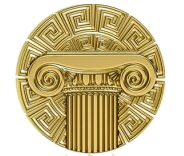 Civilization
Civilization
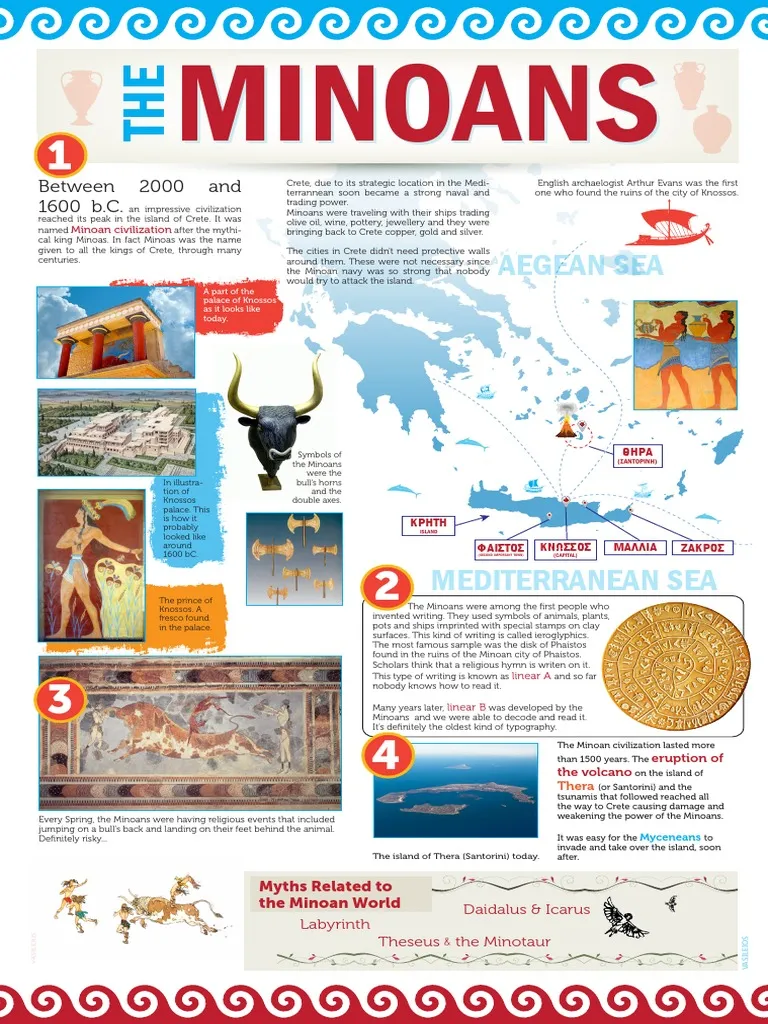
米诺斯文明(英语:Minoan civilization;德语:Minoische Kultur),或译迈诺斯文明、克里特文明、迈诺安文明、迈诺亚文明等,是克里特岛和其他爱琴海群岛上的青铜器时代爱琴海文明。其最早的起源可以追溯到公元前3500年,复杂的城市文明始于公元前2000年左右,然后自公元前1450年开始衰落,公元前1100年左右结束,在早期的希腊黑暗时代,是当时地中海周围地区青铜时期晩期崩溃的一部分。它代表了欧洲最早之进一步发展的文明,留下了众多庞大的建筑群、精巧的艺术,以及文字书写系统。它的经济受益于地中海大部分地区的贸易网络。
20世纪初,考古学家亚瑟·埃文斯爵士率先发掘该文明之遗迹。 “米诺斯”这个名字源自希腊神话中的米诺斯国王,并由埃文斯指定为该文明之名称,他将克诺索斯之遗址确定为米诺陶洛斯的迷宫。 米诺斯文明被描述为同类文明中在欧洲年代最早者[1],历史学家威尔·杜兰特称米诺斯文明为“欧洲文明链中的最初环节”。
Nach dem mythischen König Minos wird die bronzezeitliche Kultur Kretas als minoisch, kretisch-minoisch oder kretominoisch bezeichnet. Die etwa gleichzeitige Kultur des griechischen Festlandes wird als Helladische Kultur oder Helladikum bezeichnet. Die minoische Kultur ist die früheste Hochkultur Europas. Ihre älteste Phase, Frühminoisch I, verläuft parallel zur ersten bis vierten Dynastie Ägyptens.
Übersicht, Genaueres siehe unter Chronologie und Periodisierung:
- Frühminoische Zeit von ca. 2600 bis 1900 v. Chr.
- Mittelminoische Zeit von ca. 1900 bis 1600 v. Chr.
- Spätminoische Zeit, von ca. 1600 bis 1450 v. Chr.
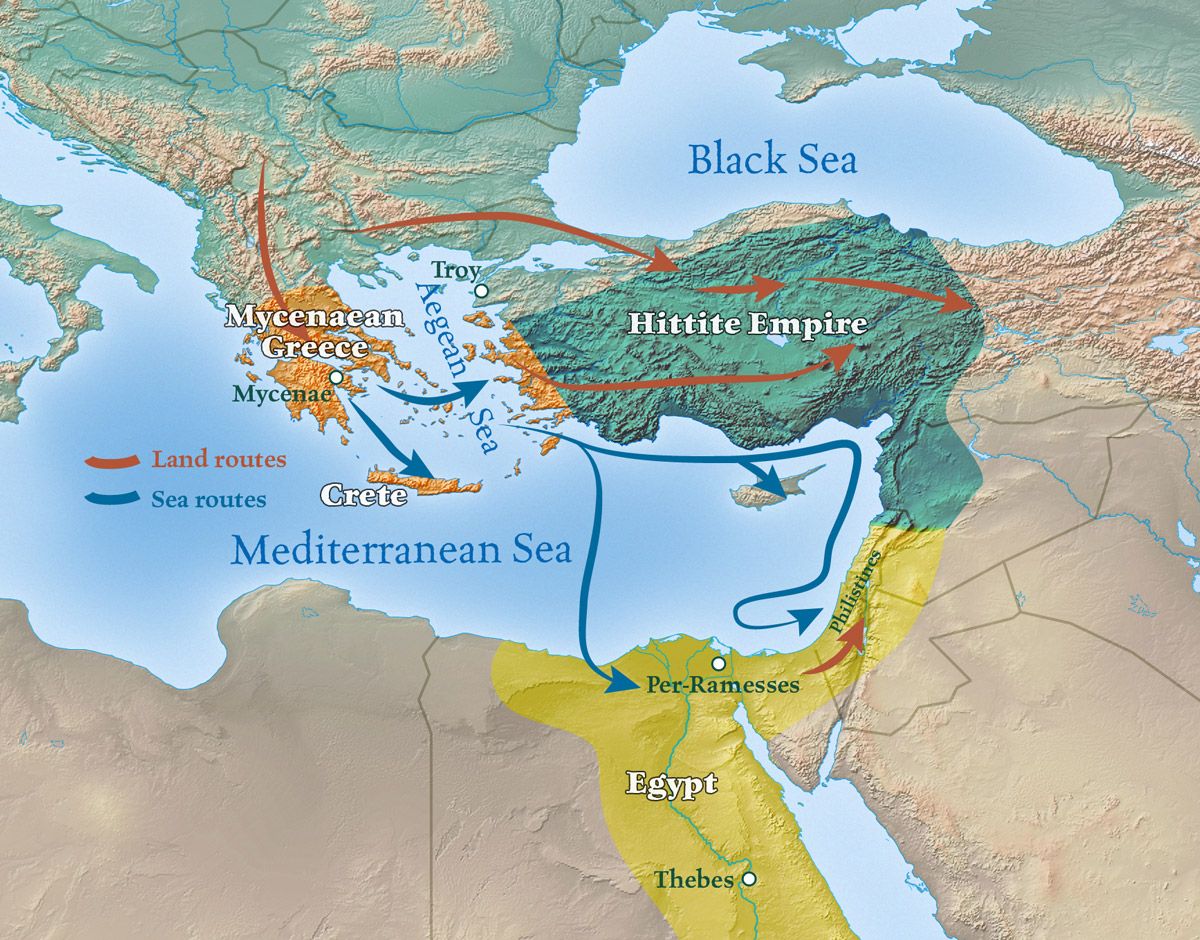
迈锡尼文明(英语:Mycenaean Greece 法文: Civilisation mycénne,前1600年 – 前1100年) 是希腊青铜时代晚期的文明,它由伯罗奔尼撒半岛的迈锡尼城而得名。这是古希腊青铜器时代的最后一个阶段,部分历史学家认为包括荷马史诗在内,大多数的古希腊文学和神话历史设定皆为此时期[1]。
Mycenaean Greece (or the Mycenaean civilization) was the last phase of the Bronze Age in Ancient Greece, spanning the period from approximately 1600–1100 BC. It represents the first advanced civilization in mainland Greece, with its palatial states, urban organization, works of art, and writing system.[1] The most prominent site was Mycenae, in the Argolid, after which the culture of this era is named. Other centers of power that emerged included Pylos, Tiryns, Midea in the Peloponnese, Orchomenos, Thebes, Athens in Central Greece and Iolcos in Thessaly.
Mycenaean and Mycenaean-influenced settlements also appeared in Epirus,[2][3] Macedonia,[4][5] on islands in the Aegean Sea, on the coast of Asia Minor, the Levant,[6] Cyprus[7] and Italy.[8]
The Mycenaean Greeks introduced several innovations in the fields of engineering, architecture and military infrastructure, while trade over vast areas of the Mediterranean was essential for the Mycenaean economy. Their syllabic script, the Linear B, offers the first written records of the Greek language and their religion already included several deities that can also be found in the Olympic Pantheon. Mycenaean Greece was dominated by a warrior elite society and consisted of a network of palace-centered states that developed rigid hierarchical, political, social and economic systems. At the head of this society was the king, known as wanax.
Mycenaean Greece perished with the collapse of Bronze Age culture in the eastern Mediterranean, to be followed by the so-called Greek Dark Ages, a recordless transitional period leading to Archaic Greece where significant shifts occurred from palace-centralized to de-centralized forms of socio-economic organization (including the extensive use of iron).[9] Various theories have been proposed for the end of this civilization, among them the Dorian invasion or activities connected to the "Sea Peoples". Additional theories such as natural disasters and climatic changes have been also suggested. The Mycenaean period became the historical setting of much ancient Greek literature and mythology, including the Trojan Epic Cycle.[10]
La civilisation mycénienne est une civilisation égéenne de l’Helladique récent (fin de l'âge du bronze) s'étendant de 1650 à 1100 av. J.-C. environ, dont l'apogée se situe environ entre 1400 et 1200 av. J.-C. Elle se répand progressivement à partir du sud de la Grèce continentale sur le monde égéen dans son ensemble, qui connaît pour la première fois une certaine unité culturelle. Cette civilisation est notamment caractérisée par ses palais-forteresses, ses différents types de poterie peinte que l'on retrouve tout autour de la mer Égée, ainsi que son écriture, le linéaire B, la plus ancienne écriture connue transcrivant du grec. Depuis son déchiffrement par Michael Ventris et John Chadwick en 1952, la civilisation mycénienne est, de toutes les civilisations égéennes pré-helléniques, la seule connue à la fois par des vestiges archéologiques et des documents épigraphiques1.
Le terme « mycénien » a été choisi par l'archéologue Heinrich Schliemann pour qualifier cette civilisation dans la seconde moitié du XIXe siècle, avant que Charles Thomas Newton n'en définisse les caractéristiques en identifiant sa culture matérielle homogène à partir des trouvailles effectuées sur plusieurs sites2. Ce nom est repris de celui de la ville de Mycènes (Péloponnèse), d'une part parce qu'il s'agit du premier site archéologique fouillé à révéler l'importance de cette civilisation et d'autre part en raison de l'importance que revêtait cette cité dans la mémoire des auteurs grecs antiques (en premier lieu Homère, qui faisait du roi de Mycènes le chef des « Achéens »). Par la suite, Mycènes s'est révélée n'être qu'un pôle de cette civilisation parmi d'autres, mais le terme de « mycénien » est resté utilisé par convention.
La civiltà micenea è quella tipica della Grecia continentale durante l'Età del bronzo.
L'espressione, che prende origine dalla città di Micene, fu coniata da Heinrich Schliemann nel suo libro Mycenae, del 1878 e, successivamente, utilizzata dai principali studiosi dell'Egeo del Bronzo, ha guadagnato subito importanza.
Tipica di questa civiltà è la scrittura Lineare B, le cui tavolette però non riportano alcun riferimento di come queste popolazioni si chiamassero. Alcune tavolette ittite coeve pare si riferiscano ad essi come Ahhiyawa.[senza fonte] Infruttuosi per ora sono stati i tentativi di affrancare gli Achei dalla loro posizione "mitologica" per avvicinarli alla realtà storica dei Micenei, basata su reperti archeologici. I poemi omerici tramandano un'immagine distorta e fantasiosa del mondo acheo, al punto da non trattarsi di un "ricordo" vero e proprio di quella civiltà, ma di una sorta di amalgama di elementi del passato miceneo (diventato, gioco forza, mitico) con altri della società contemporanea ai poeti (protogeometrico e geometrico).
Per lungo tempo Micene è stata ritenuta una sorta di capitale della Grecia dell'epoca, mentre oggi si tende a considerarla alla stregua degli altri regni continentali greci e cretesi, spesso in lotta tra loro ma sostanzialmente autonomi[1]. Pilo per esempio sembra l'unica che si sia dovuta preparare per un'invasione e che questa difesa sia stata organizzata in maniera autonoma e indipendente dagli altri centri, come evidenziato dalle numerose tavolette in lineare B colà trovate. Detto questo Tebe è l'unica città menzionata direttamente in tutti gli archivi (Cnosso, Pilo, Micene e la stessa Tebe): sembra quindi che abbia esercitato un ruolo politico molto importante, come peraltro traspare anche dal fatto di essere al centro di numerosi e fondanti miti panellenici (fondata da Cadmo che fa conoscere la scrittura agli uomini; luogo di nascita di Ercole, Dioniso e Demetra; la storia di Edipo e del ciclo tebano dei Sette e degli Epigoni).
La civilización micénica se desarrolló en el período prehelénico del Heládico reciente, es decir, al final de la Edad del Bronce, entre 1600-1100 a. C. Representa la primera civilización avanzada de la Grecia continental con sus estados palaciales, organización urbana, obras de arte y sistema de escritura.1 Entre los centros de poder que surgieron en su seno destacaron Pilos, Tirinto y Midea en el Peloponeso; Orcómeno, Tebas y Atenas en la Grecia Central y Yolco en Tesalia. Sin embargo, la ciudad más interesante fue Micenas, ubicada en la Argólida, y que da nombre a toda esta civilización. Los asentamientos influidos por Micenas también han aparecido en Epiro, Macedonia, Anatolia, el Levante mediterráneo, Chipre e Italia.
Los griegos micénicos introdujeron diversas innovaciones en el campo de la ingeniería, la arquitectura y la infraestructura militar, mientras que comerciaron por vastas zonas del Mediterráneo como actividad esencial de su economía. Su sistema de escritura silabario, el Lineal B, ofrece los primeros registros escritos del idioma griego, mientras que la religión micénica ya incluía varias divinidades que luego formarían parte de los Dioses olímpicos. La Grecia micénica estuvo dominada por una élite social guerrera y consistía en una red de estados palaciales que desarrollaron unos rígidos sistemas jerárquicos, políticos, sociales y económicos. A la cabeza de su sociedad se encontraba el rey, llamado anax.
El mundo micénico pereció durante el colapso de la Edad del Bronce Final en el Mediterráneo oriental para ser relevado por la llamada Edad Oscura griega, un período de transición del que poco conocemos y que daría paso a la Época arcaica, en la que ocurrieron giros significantes desde formas de organización socioeconómicas centralizadas en los palacios a descentralizadas y se introdujo el trabajo extensivo del hierro. Sobre el final de esta civilización se han propuesto varias teorías, entre ellas la de la invasión dórica o actividades conectadas con los Pueblos del mar. También se han defendido explicaciones como desastres naturales o cambios climáticos. El período micénico se convirtió en escenario histórico de gran parte de la literatura y la mitología griegas, incluyendo el Ciclo troyano.
Микенская цивилизация или Ахейская Греция — культурный период в истории доисторической Греции с XVI по XI век до н. э., бронзового века, часть крито-микенской культуры. Получила своё название по городу Микены на полуострове Пелопоннес. Другими важными полисами этого периода были Аргос, Тиринф и Пилос. В противоположность минойцам, культура которых достигает расцвета благодаря мирному существованию и оживлённой торговле, микенцы были завоевателями.
Исчезновение микенской культуры связывают с Дорийским вторжением около 1200 года до н. э.

 Art
Art
 Review
Review

